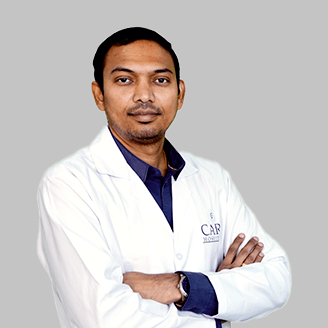-
Doctors
-
Specialities & Treatments
Centre of Excellence
Specialties
Treatments and Procedures
Hospitals & Directions HyderabadCARE Hospitals, Banjara Hills CARE Outpatient Centre, Banjara Hills CARE Hospitals, HITEC City CARE Hospitals, Nampally Gurunanak CARE Hospitals, Musheerabad CARE Hospitals Outpatient Centre, HITEC City CARE Hospitals, Malakpet
HyderabadCARE Hospitals, Banjara Hills CARE Outpatient Centre, Banjara Hills CARE Hospitals, HITEC City CARE Hospitals, Nampally Gurunanak CARE Hospitals, Musheerabad CARE Hospitals Outpatient Centre, HITEC City CARE Hospitals, Malakpet Raipur
Raipur
 Bhubaneswar
Bhubaneswar Visakhapatnam
Visakhapatnam
 Nagpur
Nagpur
 Indore
Indore
 Chh. Sambhajinagar
Chh. SambhajinagarClinics & Medical Centers
Book an AppointmentContact Us
Online Lab Reports
Book an Appointment
Consult Super-Specialist Doctors at CARE Hospitals

Lung Cancer
Lung Cancer
Best Lung Cancer Treatment in Hyderabad, India
The type of cancer that begins and spreads in the lungs is called lung cancer.
Lungs are the two spongy organs present in the chest that inhale oxygen and exhale carbon dioxide. The right lung comprises three sections, known as lobes, while the left lung only comprises two lobes. Compared with the right lung, the left lung is smaller in size, as it houses the heart.
When we breathe, the air containing the oxygen is taken in by the nose and is transferred to the lungs via the trachea or the windpipe. The trachea is further divided into two tubes called the bronchi. These divide further to form much smaller branches called the bronchioles. Tiny air sacs called alveoli are present at the end of the bronchioles. These alveoli perform the function of absorbing the oxygen into the blood that is inhaled from the air and giving out the carbon dioxide while exhaling.
Types of Lung Cancers
There are two main types of cancers and different treatments are suggested for these.
NON-SMALL CELL LUNG CANCER (NSCLC)
- Almost 80% of the lung cancers that are detected fall under the category of NSCLC. The cancer types that fall under this category include adenocarcinoma, squamous cell carcinoma, and large carcinoma.
-
Adenocarcinoma is usually found in cells that secrete mucus. These are found in people who are addicted to smoking or were former smokers. It can also be found in people who are non-smokers. The cancer cells in adenocarcinoma are found to grow on the outer parts of the lungs and can be detected in the initial stages. Young women are more at risk of contracting adenocarcinoma in comparison to men.
-
Heavy smokers are at risk of squamous cell carcinoma, which is found in the central part of the lungs near the bronchus. Squamous cell carcinoma has its origin in the squamous cells. These are flat cells that line the inside of the airways in the lungs.
-
Large cell carcinoma has the potential of growing in any part of the lung. This is aggressive in nature and can spread at an alarming rate, making it harder for effective treatment.
SMALL CELL CANCER
This is also termed oat cell cancer, and 10-15 % of people are diagnosed with small cell cancer. This type of cancer is capable of spreading at an alarming rate because of its high growth rate. Treatments like chemotherapy and radiation therapy are much more effective.
LUNG CARCINOID TUMOURS
This accounts for only 5 percent of the people diagnosed with lung cancers. These are slow in growth.
-
Other types of lung tumours that are diagnosed include adenoid cystic carcinomas, lymphomas, and sarcomas.
-
There are other types of cancers that spread/metastasize to the lungs from other organs like the breasts, kidneys, pancreas, and skin.
What are the stages of Lung Cancer?
Cancer is typically categorized by its stage, determined by factors such as the size of the initial tumor, its depth into surrounding tissue, and whether it has spread to lymph nodes or other organs. Staging criteria vary for each type of cancer.
In the case of lung cancer, the staging is as follows:
- Stage 0 (in-situ): Cancer is confined to the top lining of the lung or bronchus and has not spread to other lung areas or beyond.
- Stage I: Cancer is localized within the lung and has not spread outside of it.
- Stage II: Cancer is larger than in Stage I, has spread to lymph nodes within the lung, or there are multiple tumors in the same lung lobe.
- Stage III: Cancer is larger than in Stage II, has extended to nearby lymph nodes or structures, or there are multiple tumors in a different lobe of the same lung.
- Stage IV: Cancer has spread to the other lung, the fluid around the lung, the fluid around the heart, or distant organs.
In addition to the numerical staging, small cell lung cancer (SCLC) can also be classified as limited or extensive stage:
- Limited stage SCLC: Confined to one lung and may involve lymph nodes in the middle of the chest or above the collar bone on the same side.
- Extensive stage SCLC: Widespread throughout one lung or has spread to the other lung, lymph nodes on the opposite side of the lung, or other parts of the body.
Symptoms of Lung Cancer
The symptoms of lung cancer are not visible in the initial stages. Some symptoms that are noticed in the advanced stages are ;
- Persistent or worsening cough
- Difficulty breathing or shortness of breath (dyspnea)
- Chest pain or discomfort
- Wheezing.
- Coughing up blood (hemoptysis)
- Hoarseness.
- Loss of appetite
- Unexplained weight loss
- Fatigue (tiredness) without an apparent cause
- Shoulder pain
- Swelling in the face, neck, arms, or upper chest (superior vena cava syndrome)
- Constricted pupil and drooping eyelid in one eye with reduced or absent sweating on that side of the face (Horner’s syndrome)
Causes of Lung Cancer
-
Heavy smoking is the most prominent cause of lung cancer. People who smoke and those who are exposed to secondhand smoke- both are equally prone to the complications caused by lung cancers. Smoking damages the cells lining the lungs. Inhaling the cigarette smoke, consisting of carcinogens, affects the lung tissues and the effects are visible immediately. Initially, the body is capable of repairing the damage that is caused, but with repeated exposure, the normal cells undergo damage. This damage over a long period of time will lead the cell to perform in an abnormal way, eventually leading to the growth of the cancer cells.
-
Previous radiation therapy can also have an adverse effect on the functioning of the lungs.
-
Exposure to the radon gas, produced by the natural breakdown of uranium and found in the soil, rock and water, can affect the air that we breathe. This can lead to the growth of cancer-causing cells in the lungs.
-
A family history of lung cancer can also be a risk for the young members of the family.
-
Heavy exposure to asbestos, arsenic, chromium, and nickel can prove to be a risk for lung cancer.
Prevention
-
Give up on smoking. It will reduce the risk of lung cancer. There are various options available to quit smoking. Options like nicotine replacement products, medications, and support groups are advised by the doctors to help the person in getting rid of smoking.
-
Follow a healthy diet filled with fruits and vegetables. These are great sources of vitamins and nutrients and help in reducing the risk of lung cancer.
-
Exercise regularly. This will help keep the body fit and healthy, thereby making it strong enough to fight any foreign particle invasion that might increase the risk of lung cancer.
-
Protect yourself from exposure to toxic chemicals. Wear a mask where it is necessary to safeguard the lungs from diseases.
-
Check the home for radon levels, especially in areas where radon levels are known to be high.
Diagnosis
-
Imaging tests such as MRI, X-rays, CT scans, etc., will help the doctor examine any abnormal growth of mass or nodule in the lungs.
-
Where the symptom involves persistent cough, the doctors usually recommend sputum cytology. The sputum is examined under the microscope to reveal the growth of any cancer-causing cells in the lungs.
-
A biopsy is also advised, where the doctor collects a sample of abnormal tissues to be examined in the laboratory.
-
Once the cancer is diagnosed, the doctor can suggest other tests that will help determine the cancer stage. The tests involve CT scan, MRI, PET, bone scans, etc.
Treatment
-
In most cases, the doctors recommend surgery to remove lung cancer. The different methods include
-
Wedge resection, where a small section of the lung that is affected is removed along with a small part of the healthy tissues.
-
Segmental resection removes a large portion of the lung, but not the entire lob
-
Lobectomy is used to remove the entire lobe of one lung.
-
Pneumonectomy is used to remove an entire lung.
-
Radiation therapy is also suggested. In this method, high-powered energy beams are used to kill the cancer cells. The patient is made to lie on the table, and the radiation is directed precisely on the body part that is affected.
-
Chemotherapy is used to kill cancer cells with the use of drugs. These drugs are injected through the veins or can be taken orally. This method is often used after the surgery is performed to kill the cancer cells that remain. This method can also be used before the surgery to shrink cancer to make it easier to remove.
-
Targeted drug treatments to focus on certain abnormalities found in the cancer cells. Blocking these abnormalities with the help of targeted drug treatment, the cancer cells will die.
-
In the process of immunotherapy, the immune system is made stronger to fight cancer cells.
-
Radiosurgery, which is intense radiation treatment, is used to aim beams of radiation at cancer.
Our Doctors
-

Dr. Ritesh Tapkire
MBBS, MS, Mch (Surgical Oncology)
Surgical Oncology
View More -

Dr. Apurva Garg
M.B.B.S, MS, FGOLF (IFHNOS-MSKCC NY), FACS Fellow (TMH Mumbai), FACS Fellow (TMH Mumbai)
Surgical Oncology
View More -

Dr. Ravi Jaiswal
MBBS, MD (Medicine), DNB (Medical Oncology), MRCP (UK), ECMO.Fellowship (USA), Medical Oncologist & Hemato-Oncologist (Adult & Pediatric) Gold Medalist
Medical Oncology
View More -

Dr. Tanuj Shrivastava
M.Ch (Cancer Surgery), MRCS,FCPS, FMAS
Surgical Oncology
View More -

Dr. Ashvin Kumar Rangole
MS (General Surgery), Mch equivalent registrarship (TMH-Mumbai)
Surgical Oncology
View More -

Dr. Amit K Jotwani
MD, FHPRT, FSBRT, FCBT, AMPH(ISB)
Radiation Oncology
View More -

Dr. Avinash Chaitanya S
MBBS, MS (ENT), Fellow in Head and Neck Surgical Oncology
Surgical Oncology
View More -

Dr. Byreddy Poojitha
MBBS, MD, DM
Haematology
View More -

Dr. Deepak Koppaka
MBBS, MD (Radiation Oncology), DM (Medical Oncology)
Medical Oncology
View More -

Dr. Geetha Nagasree N
MBBS, MD (OBG), MCh (Surgical Oncology)
Surgical Oncology
View More -

Dr. Jyothi A
MBBS, DNB(General Surgery), DrNB (Surgical Oncology)
Surgical Oncology
View More -

Dr. M. A. Suboor Shaherose
MBBS (Osm)MD (Gen Med) DrNB (Medical Oncology), ECMO
Haematology, Medical Oncology
View More -

Dr. Metta Jayachandra Reddy
MS General Surgery(AFMC Pune), DNB General Surgery, MCh Surgical Oncology(Double Gold Medalist), FAIS, FMAS, MNAMS, FACS(USA), FICS(USA)
Surgical Oncology
View More -

Dr. Nossam Rama Subba Reddy
MBBS, MS, MCh
Surgical Oncology
View More -

Dr. Pragna Sagar Rapole S
MBBS, MD (Radiation Oncology)
Radiation Oncology
View More -

Dr. Saleem Shaik
MBBS, MS (General Surgery), DrNB Surgical Oncology
Surgical Oncology
View More -

Dr. Sarath Chandra Reddy
MBBS, DNB (Radiation Oncology)
Radiation Oncology
View More -

Dr. Satish Pawar
MBBS, MS (General Surgery), DNB (Surgical Oncology), FMAS, FAIS, MNAMS, Fellowship GI Oncology
Surgical Oncology
View More -

Dr. Suyash Agarwal
MBBS, General Surgery (DNB), Surgical Oncology (DrNB)
Surgical Oncology
View More -

Dr. Swaroopa Chundru
MBBS, DM (Medical Oncology)
Medical Oncology
View More -

Dr. Syed Touseef
MBBS, DNB, PDCR
Radiation Oncology
View More -

Dr. Vikranth Mummaneni
MBBS, MS, DNB
Surgical Oncology
View More -

Dr. Yugandar Reddy
MBBS, MS (General Surgery), DNB (Surgical Oncology)
Surgical Oncology
View More
Frequently Asked Questions
Still Have a Question?

